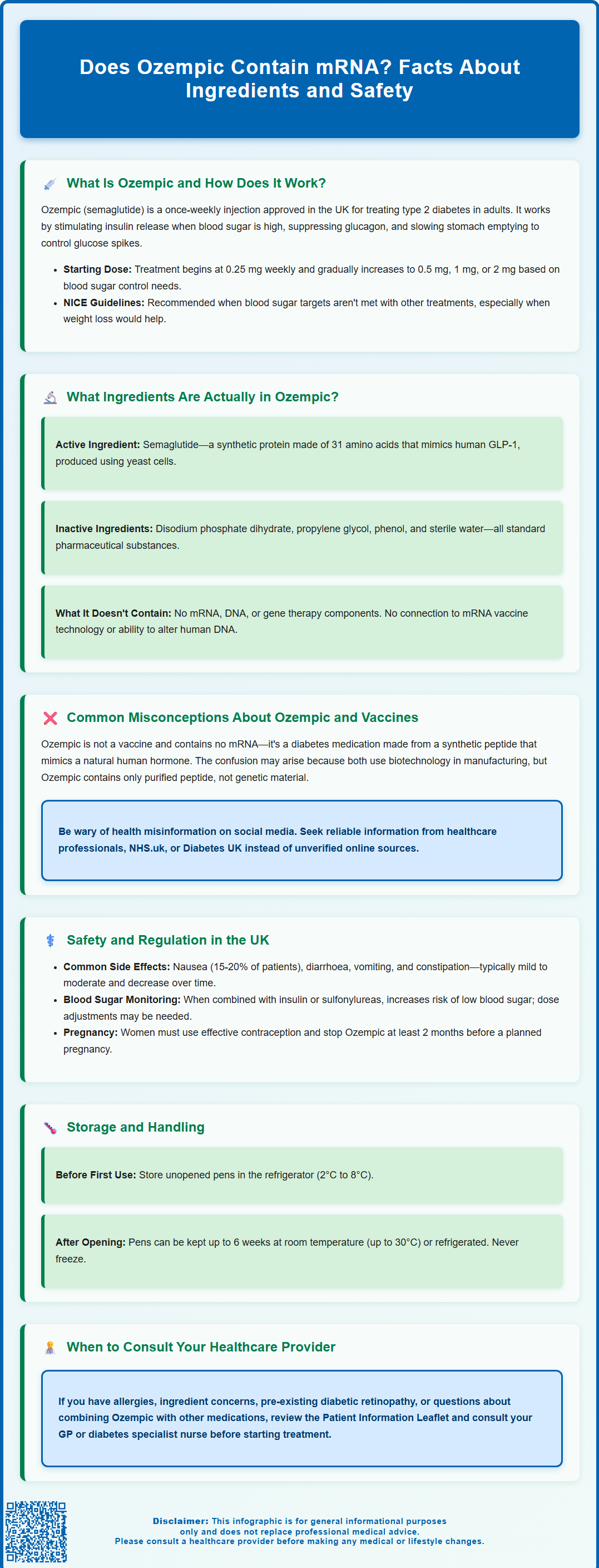Mounjaro®
Dual-agonist support that helps curb appetite, hunger, and cravings to drive substantial, sustained weight loss.
- ~22.5% average body weight loss
- Significant weight reduction
- Improves blood sugar levels
- Clinically proven weight loss

Concerns have emerged online questioning whether Ozempic contains mRNA, often conflating this diabetes medication with vaccine technology. Ozempic (semaglutide) is a glucagon-like peptide-1 (GLP-1) receptor agonist licensed in the UK for treating type 2 diabetes mellitus in adults. It contains no mRNA, DNA, or genetic material whatsoever. The medication consists of a synthetic peptide that mimics a naturally occurring human hormone, produced through established biotechnology methods. This article clarifies Ozempic's actual composition, addresses common misconceptions, and provides evidence-based information about its safety and regulation in the UK.
Summary: Ozempic contains no mRNA, DNA, or genetic material—it is a conventional diabetes medication containing semaglutide, a synthetic peptide that mimics a natural human hormone.
Ozempic (semaglutide) is a prescription medication licensed in the UK for the treatment of type 2 diabetes mellitus in adults. It belongs to a class of drugs called glucagon-like peptide-1 (GLP-1) receptor agonists, which work by mimicking the action of a naturally occurring hormone in the body.
The mechanism of action involves several complementary pathways. Semaglutide binds to GLP-1 receptors on pancreatic beta cells, stimulating insulin secretion in a glucose-dependent manner—meaning it primarily triggers insulin release when blood glucose levels are elevated. Additionally, Ozempic suppresses glucagon secretion, a hormone that raises blood sugar, and slows gastric emptying, which helps moderate post-meal glucose spikes.
Beyond glycaemic control, many patients experience weight loss as a secondary benefit, primarily due to reduced appetite and increased satiety. While this effect has led to interest in semaglutide for weight management, it's important to note that Ozempic is specifically licensed for diabetes treatment in the UK. For weight management, a different semaglutide product (Wegovy) is licensed in the UK.
Ozempic is administered as a once-weekly subcutaneous injection using a pre-filled pen device. Treatment typically starts with a lower dose (0.25 mg weekly for 4 weeks), which is then increased to 0.5 mg, with further increases to 1 mg or 2 mg if needed for glycaemic control.
According to NICE guidance (NG28), GLP-1 receptor agonists like Ozempic may be considered for adults with type 2 diabetes when glycaemic targets are not met on other therapies, particularly when weight loss would be beneficial or in people with established cardiovascular disease where agents with proven cardiovascular benefit are preferred.
It's important to note that when Ozempic is used with insulin or sulfonylureas, there is an increased risk of hypoglycaemia, and dose reductions of these medications may be needed.

Understanding the actual composition of Ozempic is essential for addressing concerns about its ingredients. The medication contains a clearly defined list of components, all of which are conventional pharmaceutical substances.
The active ingredient is semaglutide, a synthetic peptide analogue of human GLP-1. This is a protein-based molecule consisting of a chain of 31 amino acids with specific chemical modifications to extend its duration of action in the body. Semaglutide is produced using recombinant DNA technology in yeast cells (Saccharomyces cerevisiae), a well-established manufacturing process used for many biological medicines.
The inactive ingredients (excipients) in Ozempic injection solution include:
Disodium phosphate dihydrate – a buffering agent that maintains pH stability
Propylene glycol – a solvent commonly used in injectable medications
Phenol – a preservative that prevents bacterial contamination in the multi-dose pen
Water for injections – the sterile liquid base
According to the SmPC, Ozempic is essentially sodium-free, containing less than 1 mmol sodium (23 mg) per dose.
These excipients are standard pharmaceutical-grade substances with long safety records in injectable medicines. Importantly, Ozempic contains no mRNA or DNA and is not a gene therapy. It has no relationship to mRNA vaccine technology and does not alter human DNA.
The complete list of ingredients is available in the Summary of Product Characteristics (SmPC) approved by the Medicines and Healthcare products Regulatory Agency (MHRA) and accessible through the electronic medicines compendium (emc) website. Patients with specific concerns about ingredients, particularly those with known allergies, should review the Patient Information Leaflet provided with the medication and discuss any concerns with their GP or diabetes specialist nurse before starting treatment.
Recent online discussions have generated confusion by incorrectly linking Ozempic to mRNA vaccine technology. It is important to address these misconceptions with factual, evidence-based information.
Ozempic is not a vaccine and contains no mRNA. The medication is a conventional diabetes treatment containing a synthetic peptide (semaglutide) that mimics a natural human hormone. In contrast, mRNA vaccines—such as those developed for COVID-19—contain messenger RNA molecules that instruct cells to temporarily produce a specific protein, triggering an immune response. These are fundamentally different technologies with entirely different purposes and mechanisms.
The confusion may stem from the fact that both semaglutide and some vaccines are produced using biotechnology methods. However, the manufacturing process for Ozempic involves using yeast cells to produce the semaglutide peptide, which is then purified and formulated into the final injectable product. The medication contains the purified peptide, not genetic material. This is standard practice for biological medicines and has been used safely for decades in products like insulin.
There is no official link between Ozempic and vaccine technology, genetic modification, or any form of gene therapy. The MHRA, which rigorously evaluates all medicines licensed in the UK, has approved Ozempic based on extensive clinical trial data demonstrating its safety and efficacy for type 2 diabetes.
Patients should be cautious about health misinformation circulating on social media platforms. Reliable information about Ozempic can be obtained from:
Your GP or diabetes healthcare team
The official Patient Information Leaflet provided with the medication
NHS.uk website and the NHS Medicines A-Z page for semaglutide
Diabetes UK website
The MHRA's public assessment reports and the SmPC on the emc website
If you have concerns about any medication, always consult a qualified healthcare professional rather than relying on unverified online sources.
Ozempic undergoes rigorous regulatory oversight in the UK to ensure it meets stringent safety, quality, and efficacy standards. The medication was centrally authorised via the European Medicines Agency (EMA) and is now regulated by the MHRA in Great Britain, with product information available on the electronic medicines compendium (emc).
The safety profile of Ozempic is well-characterised through extensive clinical studies. The most common adverse effects are gastrointestinal symptoms, including:
Nausea (reported by approximately 15-20% of patients)
Diarrhoea
Vomiting
Constipation
Abdominal pain
These effects are typically mild to moderate and often diminish over time as the body adjusts to treatment. Starting with a lower dose and gradually increasing it, as prescribed, helps minimise these symptoms. It's important to maintain adequate hydration, particularly if experiencing gastrointestinal side effects, as dehydration could affect kidney function.
Important safety considerations include:
Diabetic retinopathy complications: Rapid improvement in glucose control has been associated with temporary worsening of diabetic retinopathy. Patients with pre-existing retinopathy should be monitored closely, especially during initial treatment.
Hypoglycaemia risk: When used with insulin or sulfonylureas, there is an increased risk of low blood sugar. Dose reductions of these medications may be needed.
Thyroid effects: In animal studies, semaglutide was associated with thyroid C-cell tumours. While the relevance to humans is unknown, patients should report any symptoms such as a lump in the neck or persistent hoarseness.
Pregnancy and breastfeeding: Ozempic should not be used during pregnancy or breastfeeding. Women of childbearing potential should use effective contraception and discontinue Ozempic at least 2 months before a planned pregnancy.
Storage requirements: Before first use, store in a refrigerator (2°C to 8°C). After first use, the pen may be stored for up to 6 weeks at temperatures up to 30°C or in a refrigerator. Keep the pen cap on when not in use and do not freeze.
The MHRA operates a Yellow Card scheme where healthcare professionals and patients can report suspected side effects. You can report side effects directly via the Yellow Card website (yellowcard.mhra.gov.uk) or the Yellow Card app. This pharmacovigilance system ensures any emerging safety signals are promptly investigated.
Ozempic should only be used under medical supervision as part of a comprehensive diabetes management plan that includes dietary modification and physical activity. It is not suitable for type 1 diabetes or diabetic ketoacidosis.
No, Ozempic is not related to mRNA vaccine technology. It is a conventional diabetes medication containing a synthetic peptide (semaglutide) that mimics a natural human hormone, with no genetic material or connection to vaccine development.
The active ingredient in Ozempic is semaglutide, a synthetic peptide consisting of 31 amino acids. It is produced using recombinant DNA technology in yeast cells and acts as a GLP-1 receptor agonist to help control blood glucose levels in type 2 diabetes.
Ozempic is regulated by the Medicines and Healthcare products Regulatory Agency (MHRA) in the UK. The medication underwent rigorous evaluation for safety, quality, and efficacy before receiving marketing authorisation, and continues to be monitored through pharmacovigilance systems including the Yellow Card scheme.
The health-related content published on this site is based on credible scientific sources and is periodically reviewed to ensure accuracy and relevance. Although we aim to reflect the most current medical knowledge, the material is meant for general education and awareness only.
The information on this site is not a substitute for professional medical advice. For any health concerns, please speak with a qualified medical professional. By using this information, you acknowledge responsibility for any decisions made and understand we are not liable for any consequences that may result.
Lorem ipsum dolor sit amet, consectetur adipiscing elit, sed do eiusmod tempor incididunt ut labore et dolore magna aliqua. Ut enim ad minim veniam, quis nostrud exercitation ullamco laboris nisi ut aliquip ex ea commodo consequat. Duis aute irure dolor in reprehenderit in voluptate velit esse cillum dolore eu fugiat nulla pariatur.
Block quote
Ordered list
Unordered list
Bold text
Emphasis
Superscript
Subscript